The Little City-State that Could
Wednesday 29 September 1999 Ė Monday 4 October
1999
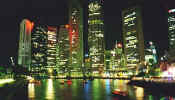 After
a pretty grueling month of travel in Indonesia, arriving in Singapore was like
finding an oasis in the middle of a desert.
International
standard hotels, Pizz
After
a pretty grueling month of travel in Indonesia, arriving in Singapore was like
finding an oasis in the middle of a desert.
International
standard hotels, Pizz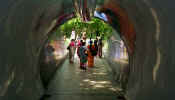 a Hut, Starbucks, internet cafes that actually functioned;
you name it, we loved it. Amazingly,
this mini-metropolis situated on an island was once a tropical jungle.
All that Stamford Raffles and his crew found on their arrival in the
early 19th century was impenetrable mangrove swamps lining the shore,
and even today there are botanic gardens, parks and wide-open spaces scattered
liberally around the cityscape.
a Hut, Starbucks, internet cafes that actually functioned;
you name it, we loved it. Amazingly,
this mini-metropolis situated on an island was once a tropical jungle.
All that Stamford Raffles and his crew found on their arrival in the
early 19th century was impenetrable mangrove swamps lining the shore,
and even today there are botanic gardens, parks and wide-open spaces scattered
liberally around the cityscape.
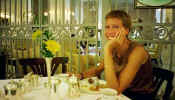
 Singapura, or 'Lion City', has today as its symbol the merlion, a mythical creature with a lionís
head and a fishís tail. It
was probably thanks to Sir Stamford Raffles, who founded a British port here, that
Singapore developed
as it did. Today,
statues of him are sprinkled liberally across the city and his name adorns many
fine establishments, buildings,
roads and parks, not least the world-renowned Raffles Hotel.
Keen as we were to try it out just for a night, with a starting price of
$400 per room, we settled for something somewhat cheaper and opted instead for a
proper afternoon tea after a day of sightseeing.
Singapura, or 'Lion City', has today as its symbol the merlion, a mythical creature with a lionís
head and a fishís tail. It
was probably thanks to Sir Stamford Raffles, who founded a British port here, that
Singapore developed
as it did. Today,
statues of him are sprinkled liberally across the city and his name adorns many
fine establishments, buildings,
roads and parks, not least the world-renowned Raffles Hotel.
Keen as we were to try it out just for a night, with a starting price of
$400 per room, we settled for something somewhat cheaper and opted instead for a
proper afternoon tea after a day of sightseeing.
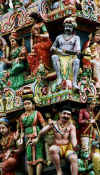 In
the five days we had, we scoured most the city centre, especially the shopping
malls. With
a population of only three million, it is perhaps surprising to find the degree
of ethnic diversity there is in Singapore but this
In
the five days we had, we scoured most the city centre, especially the shopping
malls. With
a population of only three million, it is perhaps surprising to find the degree
of ethnic diversity there is in Singapore but this 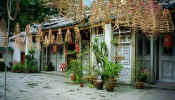 eclectic cultural mix is what
makes the city so interesting. Chinatown still has some of the sights, sounds and rituals of
a Chinese city; Little India is a microcosm of the subcontinent; Arab Street
daily life revolves around the calls from the mosque; and the colonial past is
in evidence on virtually every street corner.
But there is no doubt that modern Singapore is essentially a Chinese city
with strong western influences. Did we mention the wonderful shopping
centers?
eclectic cultural mix is what
makes the city so interesting. Chinatown still has some of the sights, sounds and rituals of
a Chinese city; Little India is a microcosm of the subcontinent; Arab Street
daily life revolves around the calls from the mosque; and the colonial past is
in evidence on virtually every street corner.
But there is no doubt that modern Singapore is essentially a Chinese city
with strong western influences. Did we mention the wonderful shopping
centers?
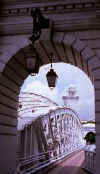
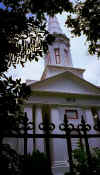
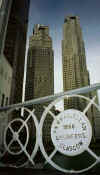
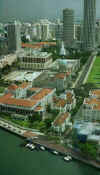
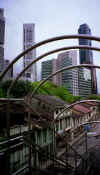 Singapore
is an exceptionally clean and pristine city and great investment has gone into
rebuilding and renovating some of the older quarters.
Despite its modernity, however, it is not the most relaxed locale in the
world: spitting can get you jail time.
The old has blended
in well with the new, however, and there are some beautiful places to eat, relax
or simply meander to take in the vibrancy of the city itself.
Having said that, some things did seem to go a little too far: in what
other city in the world would you find a swimming pool, health & beauty
centres not to mention a cinema and museum Ö at the airport?!
Singapore
is an exceptionally clean and pristine city and great investment has gone into
rebuilding and renovating some of the older quarters.
Despite its modernity, however, it is not the most relaxed locale in the
world: spitting can get you jail time.
The old has blended
in well with the new, however, and there are some beautiful places to eat, relax
or simply meander to take in the vibrancy of the city itself.
Having said that, some things did seem to go a little too far: in what
other city in the world would you find a swimming pool, health & beauty
centres not to mention a cinema and museum Ö at the airport?!
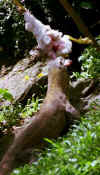 Perhaps
the most surprising highlight during our sightseeing blitz was a visit to
Singapore Zoo. Not necessarily
something you would find on the average touristís list of places to visit, but
well worth
the trip. It was undoubtedly the
most enjoyable zoo complex either of us had visited. The
enclosures were open and spacious and
Perhaps
the most surprising highlight during our sightseeing blitz was a visit to
Singapore Zoo. Not necessarily
something you would find on the average touristís list of places to visit, but
well worth
the trip. It was undoubtedly the
most enjoyable zoo complex either of us had visited. The
enclosures were open and spacious and 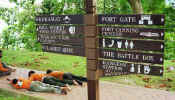 one, the Fragile Forest, allowed you to
walk through a pseudo (but very realistic) jungle literally brushing shoulders
with the animals (lemurs, mouse deer, all kinds of birds and reptiles).
Unfortunately, even after all
the orangutans in Borneo, we still hadnít learnt our lesson on animal
photography and most of the pictures leave a lot to be desired!
one, the Fragile Forest, allowed you to
walk through a pseudo (but very realistic) jungle literally brushing shoulders
with the animals (lemurs, mouse deer, all kinds of birds and reptiles).
Unfortunately, even after all
the orangutans in Borneo, we still hadnít learnt our lesson on animal
photography and most of the pictures leave a lot to be desired!
Five days on, and we were
revived and ready to hit the next leg of our journey, this time travelling
overland by bus up through the Malay peninsular to Bangkok.